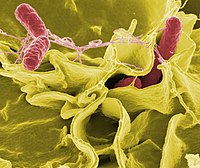
Study of biodegradation of chloramphenicol by endophytic fungi isolated from Bertholletia excelsa (Brazil nuts)
Sign Up to like & getrecommendations! Published in 2019 at "Biocatalysis and Agricultural Biotechnology"
DOI: 10.1016/j.bcab.2019.101200
Abstract: Abstract Chloramphenicol (CAP) is a micropollutant that resists to conventional residual water treatment. Therefore, the aim of this study was to assess CAP biodegradability by five endophytic fungi strains isolated from Bertholletia excelsa collected in… read more here.
Keywords: isolated bertholletia; cap; bertholletia excelsa; chloramphenicol ... See more keywords

Degradation of Chloramphenicol with Novel Metal Foam Electrodes in Bioelectrochemical Systems
Sign Up to like & getrecommendations! Published in 2017 at "Electrochimica Acta"
DOI: 10.1016/j.electacta.2017.04.059
Abstract: Abstract Bioelectrochemical system (BES) has been considered as one of the efficient methods for recalcitrant organic pollutant removal. This study compared three different cathodes, i.e. carbon rod (CR), copper foam (Cu), nickel foam (NF), for… read more here.
Keywords: degradation; chloramphenicol; foam; removal ... See more keywords

Facile preparation of intercrossed-stacked porous carbon originated from potassium citrate and their highly effective adsorption performance for chloramphenicol.
Sign Up to like & getrecommendations! Published in 2017 at "Journal of colloid and interface science"
DOI: 10.1016/j.jcis.2017.06.062
Abstract: Recently, antibiotics pollution has attracted more interests from many researches which causes potential risks on the ecosystem and human health. Herein, the porous carbons (PCs) was prepared by directly simultaneous carbonization/self-activation of potassium citrate at… read more here.
Keywords: adsorption; chloramphenicol; pcpcs 850; performance ... See more keywords

Photochemical degradation of chloramphenicol over jarosite/oxalate system: Performance and mechanism investigation
Sign Up to like & getrecommendations! Published in 2020 at "Journal of environmental chemical engineering"
DOI: 10.1016/j.jece.2020.104570
Abstract: Abstract Rational selection of affordable catalyst and effective degradation process are significant for antibiotic-containing wastewater treatment. Herein, a photochemical catalytic system comprising of bio-synthesized jarosite and oxalic acid (Ox) was investigated for degradation of antibiotic… read more here.
Keywords: system; cap; process; chloramphenicol ... See more keywords

Comparative In Vitro Activities of Meropenem in Combination with Colistin, Levofloxacin, or Chloramphenicol Against Achromobacter xylosoxidans Strains Isolated from Patients with Cystic Fibrosis.
Sign Up to like & getrecommendations! Published in 2020 at "Journal of global antimicrobial resistance"
DOI: 10.1016/j.jgar.2020.06.001
Abstract: OBJECTIVES Achromobacter xylosoxidans is an emerging pathogen in cystic fibrosis (CF). Relatively little is known about its clinical impact and optimal management. In the present study, the in vitro bactericidal activities of meropenem, either alone… read more here.
Keywords: combination; achromobacter xylosoxidans; cystic fibrosis; chloramphenicol ... See more keywords

Solution growth of 1D zinc tungstate (ZnWO4) nanowires; design, morphology, and electrochemical sensor fabrication for selective detection of chloramphenicol.
Sign Up to like & getrecommendations! Published in 2019 at "Journal of hazardous materials"
DOI: 10.1016/j.jhazmat.2018.12.072
Abstract: Development of 1D nanostructures with novel morphology is a recent scientific attraction, so to say yielding unusual materials for advanced applications. In this work, we have prepared solution grown, single-pot 1D ZnWO4 nanowires (NWs) and… read more here.
Keywords: detection; chloramphenicol; solution; spectroscopy ... See more keywords

Magnetic assisted fluorescence immunoassay for sensitive chloramphenicol detection using carbon dots@CaCO3 nanocomposites.
Sign Up to like & getrecommendations! Published in 2021 at "Journal of hazardous materials"
DOI: 10.1016/j.jhazmat.2020.123942
Abstract: Analytical methods with high sensitivities and short assay times are urgently required for the screening of "zero tolerance" hazardous substances in food. Herein, we propose a fluorescent immunoassay for the highly sensitive and rapid analysis… read more here.
Keywords: cap; immunoassay; chloramphenicol; carbon dots ... See more keywords

In situ electrogeneration and activation of H2O2 by atomic Fe catalysts for the efficient removal of chloramphenicol.
Sign Up to like & getrecommendations! Published in 2021 at "Journal of hazardous materials"
DOI: 10.1016/j.jhazmat.2021.125162
Abstract: Heterogeneous electron-Fenton processes have been regarded as promising, environmentally friendly techniques for the removal of refractory organics. A new strategy has been brought forward for an electron-Fenton-like process with in situ H2O2 production, but regarding… read more here.
Keywords: chloramphenicol; removal chloramphenicol; h2o2; situ electrogeneration ... See more keywords

Electroresponsive and pH-Sensitive Hydrogel as Carrier for Controlled Chloramphenicol Release.
Sign Up to like & getrecommendations! Published in 2023 at "Biomacromolecules"
DOI: 10.1021/acs.biomac.2c01442
Abstract: Multiresponsive hydrogels, which are smart soft materials that respond to more than one external stimulus, have emerged as powerful tools for biomedical applications, such as drug delivery. Within this context and with the aim of… read more here.
Keywords: hydrogel; electroresponsive sensitive; chloramphenicol; release ... See more keywords

Bismuth-Doped Nano Zerovalent Iron: A Novel Catalyst for Chloramphenicol Degradation and Hydrogen Production
Sign Up to like & getrecommendations! Published in 2020 at "ACS Omega"
DOI: 10.1021/acsomega.0c04574
Abstract: In this study, we showed that doping bismuth (Bi) at the surface of Fe0 (Bi/Fe0, bimetallic iron system)—synthesized by a simple borohydride reduction method—can considerably accelerate the reductive degradation of chloramphenicol (CHP). At a reaction… read more here.
Keywords: degradation; fe0; chloramphenicol; iron ... See more keywords

Combined exposure to non-antibiotic pharmaceutics and antibiotics in the gut synergistically promote the development of multi-drug-resistance in Escherichia coli
Sign Up to like & getrecommendations! Published in 2022 at "Gut Microbes"
DOI: 10.1080/19490976.2021.2018901
Abstract: ABSTRACT The gut microbiota represents an important reservoir of antibiotic-resistant bacteria (ARB), which poses a significant threat to public health. However, little is known about the emergence of ARB in the gut after the combined… read more here.
Keywords: non antibiotic; antibiotic pharmaceutics; chloramphenicol; resistance ... See more keywords